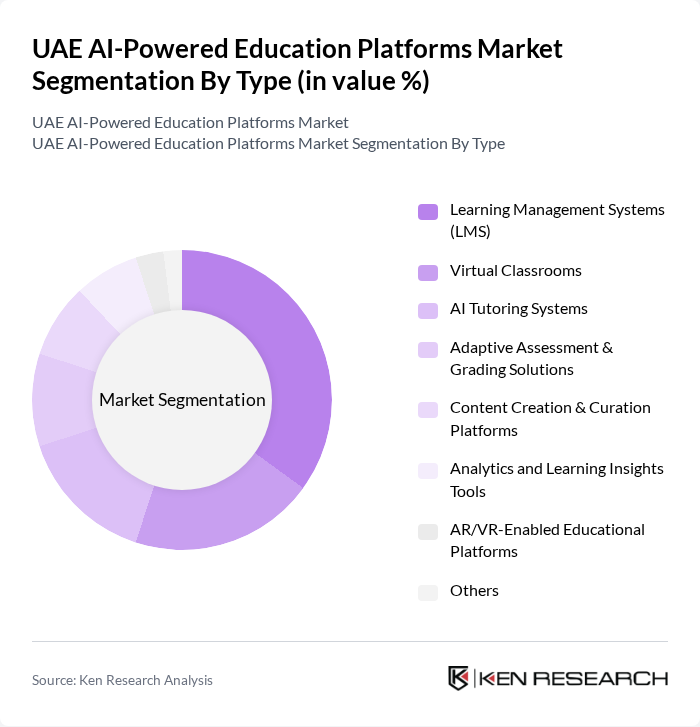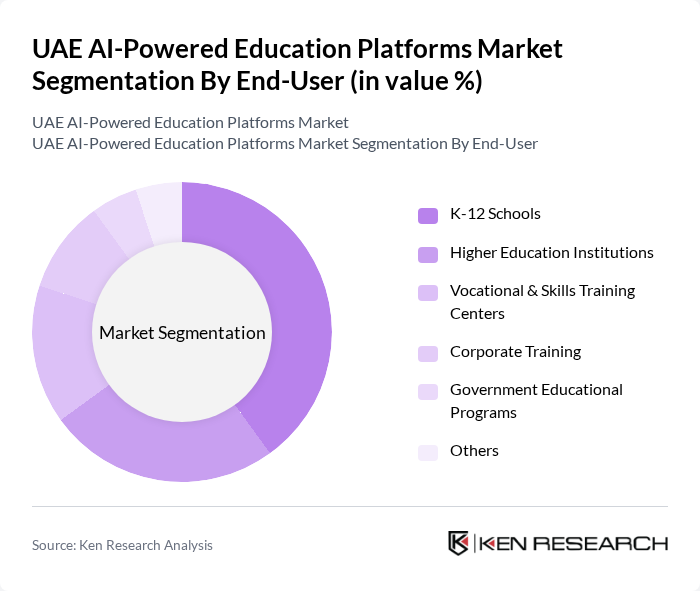Region:Middle East
Author(s):Geetanshi
Product Code:KRAA3650
Pages:87
Published On:September 2025

By Type:The market is segmented into Learning Management Systems (LMS), Virtual Classrooms, AI Tutoring Systems, Adaptive Assessment & Grading Solutions, Content Creation & Curation Platforms, Analytics and Learning Insights Tools, AR/VR-Enabled Educational Platforms, and Others. Learning Management Systems (LMS) hold the largest share, reflecting their widespread use in managing, delivering, and tracking online and blended learning programs across K-12 and higher education. Virtual Classrooms and AI Tutoring Systems are also gaining traction, driven by the need for real-time interaction and personalized support .

By End-User:The end-user segmentation comprises K-12 Schools, Higher Education Institutions, Vocational & Skills Training Centers, Corporate Training, Government Educational Programs, and Others. K-12 Schools represent the largest segment, propelled by the UAE’s national digital education agenda, early adoption of EdTech in classrooms, and the focus on interactive, student-centered learning. Higher Education Institutions and Vocational Training Centers are also expanding their use of AI to support lifelong learning and workforce readiness .

The UAE AI-Powered Education Platforms Market is characterized by a dynamic mix of regional and international players. Leading participants such as Alef Education, Noon Academy, Classera, Blackboard Inc., Pearson Education, McGraw-Hill Education, Coursera Inc., Edraak, GEMS Education, Microsoft (Education Solutions), Google for Education, Smart Learning Institute (Hamdan Bin Mohammed Smart University), Eduten, Knowledge Hub, and Taaleem contribute to innovation, geographic expansion, and service delivery in this space.
The future of the UAE AI-powered education platforms market appears promising, driven by ongoing technological advancements and increasing government support. The integration of AI and machine learning in educational tools is expected to enhance learning outcomes significantly. Additionally, the rise of hybrid learning models will likely create new opportunities for educational institutions to innovate. As digital literacy becomes a priority, the demand for AI-driven solutions will continue to grow, fostering a more dynamic educational landscape in the UAE.
| Segment | Sub-Segments |
|---|---|
| By Type | Learning Management Systems (LMS) Virtual Classrooms AI Tutoring Systems Adaptive Assessment & Grading Solutions Content Creation & Curation Platforms Analytics and Learning Insights Tools AR/VR-Enabled Educational Platforms Others |
| By End-User | K-12 Schools Higher Education Institutions Vocational & Skills Training Centers Corporate Training Government Educational Programs Others |
| By Application | Curriculum Development & Personalization Student Assessment & Progress Tracking Teacher Training & Support Learning Analytics & Intervention Administrative Automation Others |
| By Distribution Channel | Direct Sales Online Platforms & Marketplaces Resellers and Distributors Partnerships with Educational Institutions Others |
| By Pricing Model | Subscription-Based One-Time Purchase Freemium Model Pay-Per-Use Others |
| By Content Type | Video Content Interactive Content Text-Based Content Assessment Content Others |
| By User Demographics | Age Group (Children, Teenagers, Adults) Learning Preferences (Visual, Auditory, Kinesthetic) Educational Background (Primary, Secondary, Tertiary) Others |
| Scope Item/Segment | Sample Size | Target Respondent Profiles |
|---|---|---|
| K-12 Schools Using AI Platforms | 100 | School Principals, IT Coordinators |
| Higher Education Institutions | 80 | University Deans, Faculty Members |
| EdTech Startups in the UAE | 50 | Founders, Product Managers |
| Parents of Students Using AI Tools | 100 | Parents, Guardians |
| Corporate Training Programs | 40 | HR Managers, Training Coordinators |
The UAE AI-Powered Education Platforms Market is valued at approximately USD 110 million, reflecting significant growth driven by the adoption of digital learning solutions and government initiatives aimed at enhancing educational technology integration.